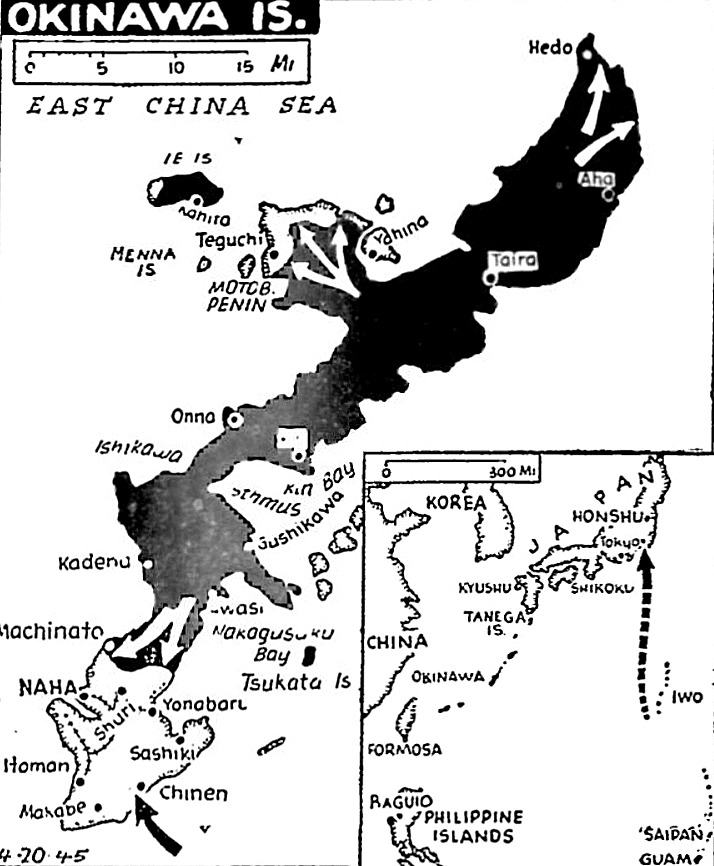The Pittsburgh Press (April 20, 1945)
Greatest offensive in Pacific underway

Heaviest offensive of the Pacific war has been launched by U.S. forces in Southern Okinawa. The Americans pushed to within 3½ miles of the capital, Naha. Tokyo reported a landing attempt southwest of Naha which would flank the capital. The Japs held only small pockets on Motobu Peninsula and Ie Island. U.S. fighters from Iwo airfields raided a Tokyo airfield (inset map).
GUAM (UP) – U.S. troops lunged to within three and a half miles north of Naha, the capital of Okinawa, in the most powerful offensive of the Pacific war today.
Radio Tokyo said other troops attempted to land on the south coast of Okinawa about eight miles southeast of Naha yesterday from a 30-ship invasion fleet, including 20 transports and several battleships.
Such a landing would outflank Naha, a city of 65.000, and clamp a pincer on its garrison of 60,000.
Smash deep bulges
Three Army divisions – possibly 45,000 men – smashed deep bulges into both flanks of the Jap line across southern Okinawa yesterday under cover of the greatest coordinated air, ship and artillery bombardment ever given American troops for the size of the target anywhere in the world.
Front reports said Americans now were less than 6,200 yards north of Naha and approaching Machinato airfield on the west coast and nearing the northern end of Yonabaru airstrip on the east coast. They were 3½ miles from the town of Yonabaru.
A hill overlooking Shuri, two miles inland from Naha, was all but cleared in the center of the line. The town of Machinato, a mile north of the airfield of the same name, was captured in the initial phases of the offensive yesterday.
Key ground won
Maj. Gen. John R. Hodge, commander of the XXIV Army Corps, said his forces had made “good gains” in the heart of the enemy’s main line of resistance. Key ground had been won, he said.
Lt. Gen. Simon Bolivar Buckner, commander of the Tenth Army, said the offensive was going “just about as we expected.”
“The Japs have as well an organized line as I have ever heard of anywhere,” Gen. Buckner said. “We all know that we still have to use a blowtorch and corkscrews to get them out of their caves.”
Tokyo radio said the amphibious forces attempted to land on the southern coast at Chinen and Minatokawa, 4½ to 5 miles south of Yonabaru, but were driven off.
Tokyo also claimed that Jap naval units had entered the Okinawa area and shelled two American-held airfields.
A Melbourne dispatch said the Australian Information Department intercepted a Tokyo broadcast that the Jap army and navy had launched a general attack in the Okinawas. The information department was quoted as saying that the broadcast suggested the Jap navy may have gone out for a big engagement.
While the troops were battering through the strong Jap lines on Okinawa, Army Mustang fighters from Iwo heavily raided the Atsugi airfield at Tokyo in the first large-scale fighter attack on the enemy’s capital.
Early reports listed 102 Jap planes as destroyed or damaged in the surprise attack on Atsugi yesterday. Returning American pilots said they sighted rows of from 200 to 300 Jap bombers and fighters lined up on the field.
In the raid, 21 Jap planes were shot down, 22 probably shot down, 26 destroyed on the ground and 33 damaged. A large cargo ship was also sunk off the coast and a medium-sized freighter left burning south of Tokyo.
Lt. Gen. Buckner launched the big offensive on Okinawa with elements of the 7th, 27th and 96th Infantry Divisions early yesterday.
Swarms of carrier planes and the big guns of battleships, cruisers and destroyers off shore also aided the infantrymen.
A Blue Network correspondent described the fighting on Okinawa as the heaviest of the Pacific War and “it is going to be bloodier by the moment.”
Gain on Ie Island
Adm. Chester W. Nimitz disclosed that Tenth Army troops on nearby Ie Island moved south of Iegusugu Peak, further compressing the small enemy pocket in the southeastern corner. He said the island’s airstrip was already being used by observation planes.
